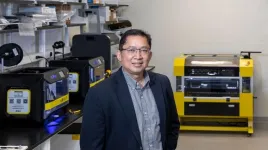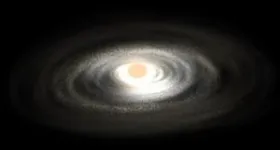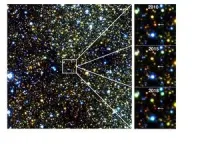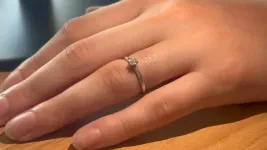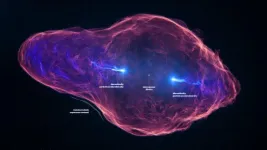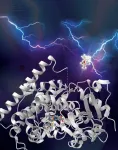(Press-News.org) Rigoberto “Gobet” Advincula has been awarded one of the highest honors of his profession.
Advincula, the University of Tennessee-Oak Ridge National Laboratory Governor’s Chair of Advanced and Nanostructured Materials, has been elected National Academy of Inventors (NAI) Fellow.
Advincula is a leader in the polymer field with inventions and many publications in polymer nanocomposites, graphene nanomaterials, polymer layered films, and coatings. He has been granted 14 US patents and has 21 published filings related to graphene nanomaterials, solid-state device fabrication, smart coatings and films, and advanced chemical additives.
“I was elated to be elected with the National Academy of Inventors because I know the people who get this award are really accomplished and dedicated toward intellectual property creation,” Advincula said. “It is a testament of my focus and our group efforts in IP and research innovation.”
Advincula is the seventh UT faculty member to be chosen as an NAI Fellow, joining Taylor Eighmy (2013), Mark Dean (2014), John Birdwell (2015), Yilu Liu (2016), Fred Wang (2017) and Michael Simpson (2018).
The 2023 Fellow class hails from 118 research universities, governmental and non-profit research institutions worldwide. This class includes 89 individuals from the Association of American Universities (AAU) institutions and 128 individuals from R1 universities that boast very high research activity. The Fellows represent 35 US states and 10 countries, with underrepresented inventors comprising 33% of this year’s class.
Collectively, the 2023 Fellows hold more than 4,600 issued US patents. The class includes two Nobel Laureates, three National Inventors Hall of Fame inductees, and twenty-two members of the National Academies of Sciences, Engineering, and Medicine. The nomination is competitive, and the case for being nominated not only considers the number of patents but the potential to contribute to society.
Advincula was chosen by the NAI selection committee for induction because he has “demonstrated a highly prolific spirit of innovation in creating and facilitating outstanding inventions that have made a tangible impact on the quality of life, economic development, and welfare of society.”
Advincula’s areas of research include utilizing the structure and functionalities of materials on a near-atomic scale, characterizing and developing new materials sensors, optics, biotechnology, energy production, and advanced manufacturing.
His patents can potentially contribute to health and safety, a resurgence in U.S. manufacturing leadership, and more efficient fossil-fuel energy generation. Several companies can license his inventions with a high potential for scalable manufacturing.
Advincula is a Fellow of the American Chemical Society (ACS), Fellow of the Polymer Chemistry Division and PMSE Division of the ACS, Fellow of the Royal Society of Chemistry (FRSC), 2023 Netzsch NATAS Fellow, and a foreign member of the Philippine National Academy of Science and Technology (NAST). He received a Lifetime Distinguished Achievement Award in 2022 from his alma mater, the University of the Philippines.
Advincula received his bachelor’s degree in chemistry from the University of the Philippines and his PhD in chemistry from the University of Florida. He did his post-doctoral work at the Max Planck Institute for Polymer Research and Stanford University.
Prior to joining the Department of Chemical and Biomolecular Engineering at UT in 2020, Advincula was a professor at Case Western Reserve University’s Department of Macromolecular Science and Engineering.
At UT and ORNL, Advincula has led and built research programs and capabilities related to additive manufacturing or 3D printing and the application of artificial intelligence in synthesis and process optimization. He is passionate about mentoring future scientists and STEM students while providing research environments that foster high research skills and innovation.
“I am genuinely interested in finding what is important in our research and what is helpful to society. I am looking for things that can also benefit the university and institution I work for,” Advincula said. “I have been fortunate to work with many talented people and get good advice over my career.”
Since its inception in 2012, the NAI Fellows program has grown to include 1,898 researchers and innovators who hold over 63,000 US patents and 13,000 licensed technologies. NAI Fellows are known for their inventions’ societal and economic impact, contributing to major advancements in science and consumer technologies. Their innovations have generated over $3 trillion in revenue and generated 1 million jobs.
The 2023 class of Fellows will be honored and presented their medals by a senior United States Patent and Trademark Office (USPTO) official at the NAI 13th Annual Conference on June 18, 2024, in Raleigh, N.C.
“I look forward to the induction ceremony because I know I will meet some colleagues there who have been awarded, too,” Advincula said. “I am excited to meet the previous NAI Fellows and new NAI members. It will be like a reunion for all of us.”
Contact
Rhiannon Potkey (865-974-0683, rpotkey@utk.edu)
END
Advincula earns prestigious NAI fellow honor
2024-01-25
ELSE PRESS RELEASES FROM THIS DATE:
Sweat-analyzing temporary tattoo research funded in NSF grant to UMass Amherst researcher
2024-01-25
AMHERST – University of Massachusetts Amherst researchers have received an award to develop a new type of sweat monitor that can be applied to the skin just like a temporary tattoo and assess the molecules present, such as cortisol. The tattoos will ultimately give individuals better insight into their health and serve as a tool for researchers to discover new early indications of diseases.
“There are a lot of vital biomolecules that are present in sweat that we need to measure to really understand overall human performance and correlation to different ...
Simulations show how HIV sneaks into the nucleus of the cell
2024-01-25
Because viruses have to hijack someone else’s cell to replicate, they’ve gotten very good at it—inventing all sorts of tricks.
A new study from two University of Chicago scientists has revealed how HIV squirms its way into the nucleus as it invades a cell.
According to their models, the HIV capsid, which is cone-shaped, points its smaller end into the pores of the nucleus and then ratchets itself in. Once the pore is open enough, the capsid is elastic enough to squeeze through. Importantly, the scientists ...
White House rule dramatically deregulated wetlands, streams and drinking water
2024-01-25
The 1972 Clean Water Act protects the "waters of the United States" but does not precisely define which streams and wetlands this phrase covers, leaving it to presidential administrations, regulators, and courts to decide. As a result, the exact coverage of Clean Water Act rules is difficult to estimate.
New research led by a team at the University of California, Berkeley, used machine learning to more accurately predict which waterways are protected by the Act. The analysis found that a 2020 Trump administration rule removed Clean Water Act ...
How an ant invasion led to lions eating fewer zebra in a Kenyan ecosystem
2024-01-25
The invasion of non-native species can sometimes lead to large and unexpected ecosystem shifts, as Douglas Kamaru and colleagues demonstrate in a unique, careful study that traces the links between big-headed ants, acacia trees, elephants, lions, zebras, and buffalo at a Kenyan conservancy. The invasive big-headed ant species disrupted a mutualism between native ants and the region’s thorny acacia trees, in which the native ants protected the trees from grazers in exchange for a place to live. Through a combination of observations, experimental plots, and animal tracking at Ol Pejeta Conservancy, Kamaru et al. followed the ecosystem chain reaction prompted by this disruption. ...
Total organic carbon concentrations measured over Canadian oil sands reveal huge underestimate of emissions
2024-01-25
New measurements of total gaseous organic carbon concentrations in the air over the Athabasca oil sands in Canada suggest that traditional methods of estimating this pollution can severely underestimate emissions, according to an analysis by Megan He and colleagues. Using aircraft-based measurements, He et al. conclude that the total gaseous organic carbon emissions from oil sands operations exceed industry-reported values by 1900% to over 6300% across the studied facilities. “Measured facility-wide emissions represented approximately 1% of extracted petroleum, resulting in total organic ...
Machine learning model identifies waters protected under different interpretations of the U.S. Clean Water Act
2024-01-25
The U.S. Clean Water Act is a critically important part of federal water quality regulation, but the act does not define the exact waters that fall under its jurisdiction. Now, Simon Greenhill and colleagues have developed a machine learning model that helps to clarify which waters are protected from pollution under the United States’ Clean Water Act, and how recent rule changes affect protection. The model demonstrates that the waters protected under the act differ substantially depending on whether the act’s regulations follow a 2006 U.S. Supreme Court ruling or a 2020 White House rule. Under the 2006 Rapanos Supreme Court ruling, the model suggests that the Clean ...
Gamma ray observations of a microquasar demonstrate electron shock acceleration
2024-01-25
Observations of gamma rays, emitted by relativistic jets in a microquasar system, demonstrate the acceleration of electrons by a shock front, reports a new study. The microquasar SS 433 is a binary system made up of a compact object, probably a black hole, and a supergiant star. The black hole pulls material off the star and ejects plasma jets, which move at close to the speed of light. The High Energy Stereoscopic System (H.E.S.S.) is an array of five telescopes in Namibia that observe gamma rays. The H.E.S.S. ...
Astrophysical jet caught in a “speed trap”
2024-01-25
The science fiction author Arthur C. Clarke selected his own seven wonders of the world in a BBC television series in 1997. The only astronomical object he included was SS 433. It had attracted attention already in the late 1970s due to its X-ray emission and was later discovered to be at the center of a gas nebula that is dubbed the manatee nebula due to its unique shape resembling these aquatic mammals.
SS 433 is a binary star system in which a black hole, with a mass approximately ten times that of the Sun, and a star, with a similar mass but occupying a much larger volume, orbit each other with ...
Experts call for major shift in international decision-making to tackle ‘devastating’ impact of urban expansion and avoid ‘planetary catastrophe’
2024-01-25
Leading scientists are today calling for an urgent step change in global governance to save the future of worldwide cities and the planet at large.
Cities are growing at an unprecedented rate, putting overwhelming pressures on exploited land, scarce resources, and fragile ecosystems. The bold proposals, led by experts from the Universities of Bristol, Oxford and Yale, are set out in a Science journal article, proposing a new global advisory system to address the alarming impacts of urban expansion. This system would fulfil a similar function as the Intergovernmental ...
Teaching nature to break man-made chemical bonds
2024-01-25
For the first time, scientists have engineered an enzyme that can break stubborn man-made bonds between silicon and carbon that exist in widely used chemicals known as siloxanes, or silicones. The discovery is a first step toward rendering the chemicals, which can linger in the environment, biodegradable.
"Nature is an amazing chemist, and her repertoire now includes breaking bonds in siloxanes previously thought to evade attack by living organisms," says Frances Arnold, the Linus Pauling Professor of Chemical Engineering, Bioengineering and Biochemistry at Caltech and winner of the 2018 Nobel ...
